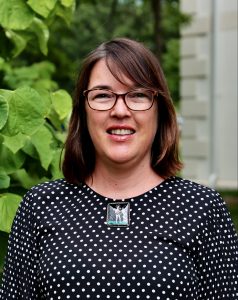How did you become interested in your BIAAS-related research project?
My introduction to Bettina Bauer-Ehrlich was the discovery, by happenstance, of the most fitting image for the cover of the volume Jazz in Word that I co-edited with Marc-Oliver Schuster. I was finishing up some research in Vienna in 2017 when I visited the show The Better Half: Jewish Women Artists Before 1938 at the Jewish Museum, exhibiting the works of Austrian women artists who fled their homeland following the Anschluss. It is there I learned about Bauer-Ehrlich and noticed her still life on the topic of jazz, the 1928 oil painting Jonny Spielt Auf, possibly inspired by Ernst Krenek’s opera by the same name and performed in Vienna in 1927. While writing a brief description about the piece, I realized what an important painter and textile artist Bauer-Ehrlich had been, yet I was unable to find much information on her life or work in print, neither about her artistic training and exhibits in Vienna and elsewhere in Europe, nor about her exile in London where she became a beloved children’s book illustrator and writer both in the United Kingdom and the United States. Then, while preparing a conference paper on Bauer-Ehrlich’s children’s books, I discovered her lifelong friendship with fellow Austrian artists Lisel Salzer and Lisl Weil, both exiled to the United States. There was also very little information about these two artists who contributed much to their communities and cultural lives in the United States. I currently feel like a detective piecing together the intertwined lives of these three important Austrian artists.
What is the significance of the transatlantic history between the US and Austria in your work? And, if this pertains to your work, how does looking at the transatlantic relationship enrich your research subject?
Bettina Bauer-Ehrlich’s children’s books, especially the Cocolo trilogy, take place in the United States where she wrote and illustrated at least the second and third book during a year-long visit. Lisl Weil and Lisel Salzer were highly influential artists in their communities in exile. The legacies of these artists highlight the contributions of Austrian artists in the United States and demonstrate how refugees, wherever they may come from and resettle, have knowledge they bring along that enriches and positively reshapes their new homeland.
What are must-read books for your topic?
For a history of Austrian Jewish life in Vienna, I am referring to Lisa Silverman’s Becoming Austrians: Jews and Culture between the World Wars. To learn more about the foundation and early works artists Lisel Salzer and Bettina Bauer-Ehrlich, the museum catalogs from the Zinkenbacher Malerkolonie provide much-needed background information. I am also buying as many of the children’s books by Bettina and Lisl Weil I can possibly find on eBay and online used bookstores in the United States and the United Kingdom.
What resource (website, archive, book, etc.) do you return to often and why?
I have found many resources on the well-curated sites of the United States Holocaust Memorial Museum and the Leo Baeck Institute on the topic of Austrian Jews in exile, such as personal documents and oral histories. I have also revisited the Zinkenbacher Malerkolonie website since it gives insight into the early professional lives of Bettina Bauer-Ehrlich and Lisel Salzer.
Which scholar(s) do you admire the most? Why?
I currently appreciate the research on Austrian Jewish history by Steven Beller, Deborah Holmes, and Lisa Silverman and the groundbreaking rediscovery of Bettina Bauer-Ehrlich and Lisel Salzer by scholars Susanne Blumensberger, Ursula Seeber, Susa Schintler-Zürner, and Christina Steinmetzer of the Zinkenbacher Malergalerie in St. Gilgen on the Wolfgangsee.
What is your favorite off the beaten path locale in the Austria/Habsburg lands?
I so enjoyed spending a few days hiking the trails overlooking the deep blue Attersee in the Salzburger lake region and eating local fish dishes and Knödel specialities at the restaurant terrace of the Landhotel Grünberg on the Traunsee. Due to the pandemic, I have only been able to armchair/online travel to Austria since early 2019.
If you could meet with any Austrian/Habsburg figure of present or old, who would it be? Why? What would you want to ask them or talk about?
I believe I would enjoy sitting in a café in Rome and meet with the Austrian author Ingeborg Bachmann, who preferred living and writing in Italy and on whose complex novels I wrote my dissertation. I would ask her to take me to her favorite sites in the city, as well as talk to her about her impressions of places she had visited, such as the United States and Egypt. Of course, I would have so loved attending one of Lisel Salzer’s weekend “salons” in Seattle where she played the cello with various local quartets and served her famous homemade Austrian cookies. I also would have taken an enamel course from her to better understand her artistic craft.
What are you currently reading? Or watching?
Oh dear, where do I begin? I much enjoy watching travel and cooking shows on Austrian ORF television as well as British mysteries and comedies on PBS or Brittbox. I subscribe to two archaeology magazines (although I have never been on a dig) and various food magazines that inspire my cooking. I also have a ridiculously tall stack of books by my bedside from which I read by mood. Currently, I am reading bits from Edmund de Waal’s The Hare with Amber Eyes, Jenny Erpenbeck’s Go, Went, Gone, E. H. Gombrich’s A Little History of the World, and Bernadine Evaristo’s Girl, Woman, Other. I recently finished the delightful Professor Chandra Follows His Bliss by Rajeev Balasubramanyam, a surprise find at a library book sale on a recent trip to Maine to visit my aunt. I will probably not finish any of these books until next summer since I have begun teaching again, but one can dream! I have the habit of never leaving an independent bookstore without a new book in hand.

